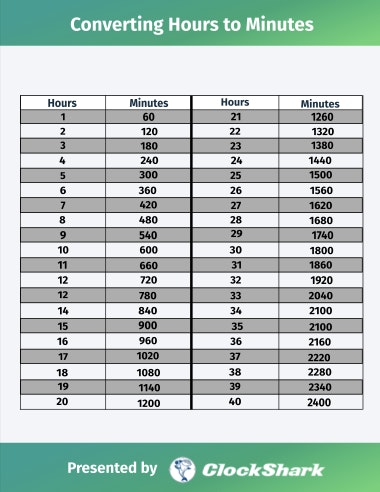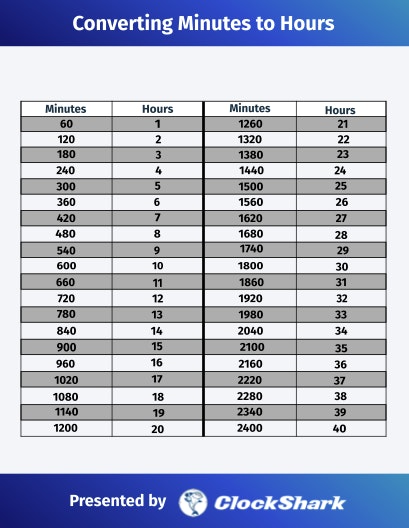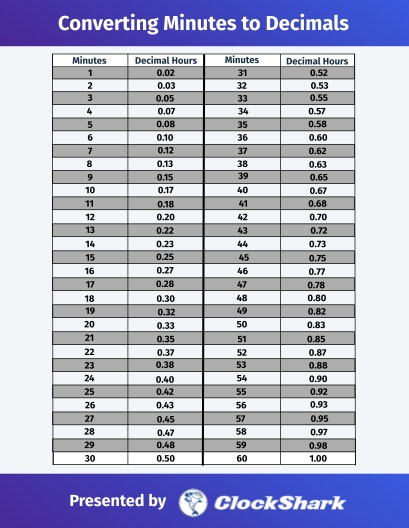Careful time clock conversion always pays off. As a business owner, you rely on every team member of yours to work efficiently to succeed.
However, many companies struggle with accurately computing time in decimals, leading to issues with payroll.
Converting fieldwork hours into decimal timesheets automates payroll calculations, avoiding manual errors and pay disputes from inaccurate budgeting.
What is a timesheet conversion?
Timesheet conversion involves changing recorded hours and minutes worked into decimal format. This often involves converting minutes to decimal hours, rounding time to the nearest quarter-hour, and calculating total hours worked.
For example, 5 hours and 30 minutes becomes 5.5 hours.
Companies using a 24-hour or "military" time format would first convert workers' hours from 24-hour time into standard AM/PM time. Then they can convert those hours and minutes into decimal format.
Why does timesheet conversion matter?
Timesheet conversion matters in today's gig economy, where hourly and contract workers track billable hours. Standardizing time as decimals:
- Ensures fair compensation: Converting hours and minutes into a decimal format allows for precise calculation of employee wages, preventing both overpayment and underpayment.
- Simplifies tax calculations: Decimal time simplifies deductions and calculations for various taxes and benefits, leading to a smoother payroll process.
Essential tools to get started
Before you get into timecard conversion to convert your workers’ times, be sure you have everything you need to get it done in one session. Examine each record and make sure it is complete and legible.
It’s wise to try to do this before lunchtime, so you’ll have time to reach out to any worker whose information is unclear. Some of our customers have experienced frustration when their employees left for the weekend and were not available to clarify their time information.
If you are converting time and misread, for example, an 8 for a 6, you could end up underpaying your employees. Conversely, mistaking a 1 for a 7 will cost you money by paying for unworked hours.
As one of the best clock-in and clock-out apps, ClockShark offers features to help businesses succeed by automatically converting time and eliminating manual entry errors. Having crew time automatically tracked allows for many time-tracking benefits, ensuring that every hour worked is accurately reflected in your team’s paychecks and that all your project costs are accurate.
Get organized
When you own or manage a business, you’ll likely have tons to do (and tons you want to get done) with little to no extra time. Payroll is a part of your job that you’ll need to set aside dedicated time to do, so you can focus on it without any interruptions.
Many construction and field service companies still use spreadsheets like Excel to keep track of their crews’ hours, but if you have missing, illegible, incomplete, or inaccurate timesheets, you will need to get all of that information before sitting down to do payroll.
One way to help ensure everyone submits their timesheets on time is to assign a supervisor in charge of collecting them.
Convert time accurately
Let’s walk through this. Say a team member works 18 hours and 45 minutes per active week. You can’t just take those minutes as decimals for payroll—that would underpay them!
Instead, you need to divide the minutes by 60, and the 45 minutes become 0.75 hours.
Once the full 18.75 hours are calculated in decimal format, you can apply the accurate wage rate multiplier and process compensation inclusive of every minute. That simple conversion ensures your crew feels valued through fair pay for work delivered.
Time clock conversion templates
Converting clocked hours into minutes can refine your workforce management operations.
Get granular insights into labor costs, ensure better job allocation, and deliver accurate paychecks on time every week.
Let’s explore how time conversion charts work.
1. Converting hours into minutes
Converting hours to minutes is easier than you may think. First, you need to understand that hours and minutes use a base of 60. That means that one hour is the same as 60 minutes.
With that in mind, you can take a look at different hour amounts and multiply them by 60.
Here are the steps:
- Step 1: Gather the information
You need to know the number of hours you want to convert to minutes. - Step 2: Multiply the hours by 60
Use a calculator or pen and paper to perform the multiplication. - Step 3: Interpret the result
The result of the multiplication will be the number of minutes.
Example:
- Suppose you have 2.5 hours and want to convert them to minutes.
- Multiply the hours by 60
- 2.5 hours * 60 minutes/hour = 150 minutes
In this example, 150 is the number of minutes.
No more calculator needed! This handy minute-to-hour chart makes payroll a breeze.
2. Converting minutes to hours
Keeping minute conversions in mind, we can easily convert minutes into hours.
Converting minutes to hours is a simple process that involves dividing the number of minutes by 60.
Here are the steps:
- Step 1: Gather the information
You'll need to know the number of minutes you want to convert to hours. - Step 2: Divide the minutes by 60
Use a calculator or pen and paper to perform the division. - Step 3: Interpret the result
The result of the division will be the number of hours, with a possible remainder representing the remaining minutes that didn't reach a full hour.
Example:
- Suppose you have 150 minutes and want to convert them to hours.
- Divide the minutes by 60
- 150 minutes / 60 = 2.5
In this example, 2.5 represents the number of hours, with no remaining minutes after the division.
Here’s a minute-to-hour payroll conversion chart, so you won’t ever need a calculator to prepare the paychecks.
3. Converting hours and minutes into decimals
We’ve established that hours and minutes have a base of 60. But converting time to a decimal format is difficult because decimals have a base of 100.
To understand these conversions, think of the 60-minute time as a whole unit (1) divided equally. For example, a full hour is now 1.0 in decimal time, while 30 minutes is 0.5 in decimal time. With this in mind, what is .75 of an hour? That would be 45 minutes.
Hours Calculator
Decimal Hours
=
Hours
Minutes
Here's how to convert hours and minutes to decimals:
- Step 1: Divide the number of minutes by 60.
This step essentially converts the minutes into a decimal fraction of an hour. - Step 2: Add the result from Step 1 to the number of hours.
This step combines the whole hour part with the decimal fraction of an hour, resulting in the final decimal representation of the time duration.
Example:
Let's convert 3 hours and 25 minutes to a decimal:
- Divide the minutes by 60
25 minutes / 60 = 0.42
- Add the result to the hours
3 hours + 0.42 = 3.42
Therefore, 3 hours and 25 minutes is equal to 3.42 in decimal form.
Download our minute-to-decimal conversion chart to get precise conversions at your fingertips.
Timesheet conversion to simplify payroll processes
It’s hard to remember so many different units and conversions for time. Like with many math-related issues, it becomes easier to have a visual guide.
Using ClockShark's timecard conversion and efficient time-tracking app, managing employee hours becomes a breeze. With features like GPS tracking, you can replace outdated paper time cards, and clocking in at the nearest job site is effortless.
Our system's seamless integration with leading payroll software like QuickBooks, ADP®, Xero, and other reputable partners is also a game-changer. You can gain efficiency by adding new jobs on the fly and enabling automated notifications. Plus, easy sharing of time-tracking data with payroll applications—including quick exports of attendance records for precise and timely paychecks.
Try our app today with a free 14-day trial and discover how we can simplify your payroll process, giving you more time to focus on what matters most.




![Time Clock Conversion Chart [+ Template Ideas]](https://www.datocms-assets.com/16247/1703693718-time-clock-conversion-chart.png?w=1200&auto=compress,format)



